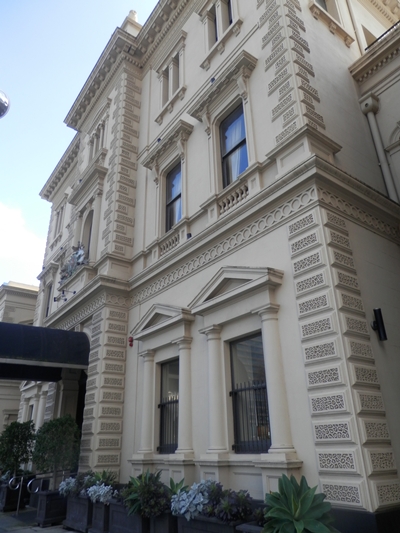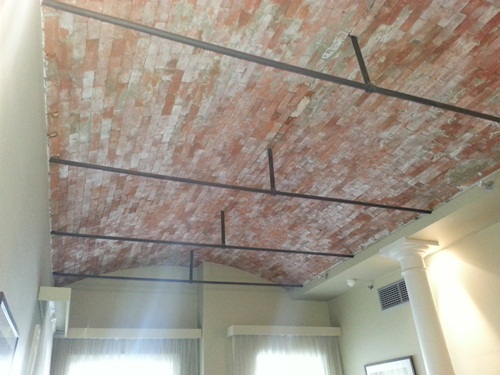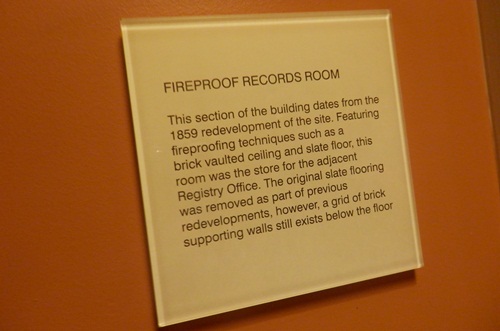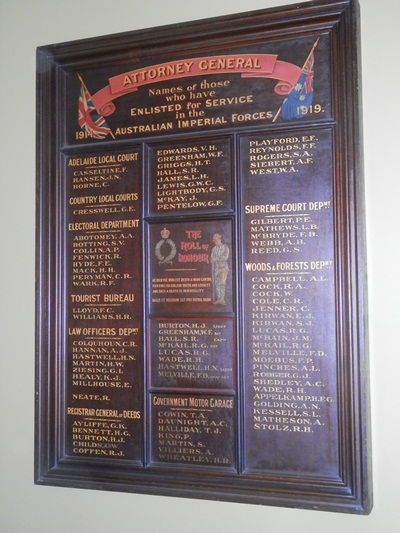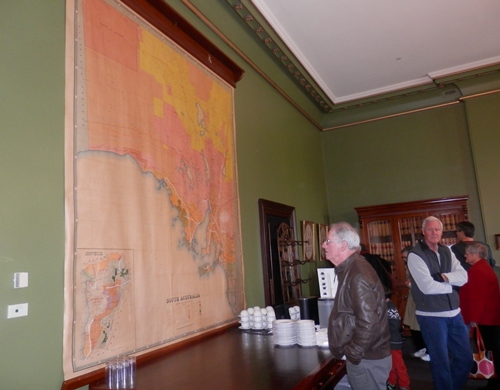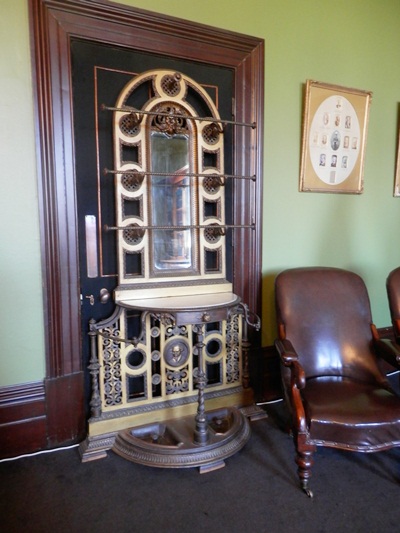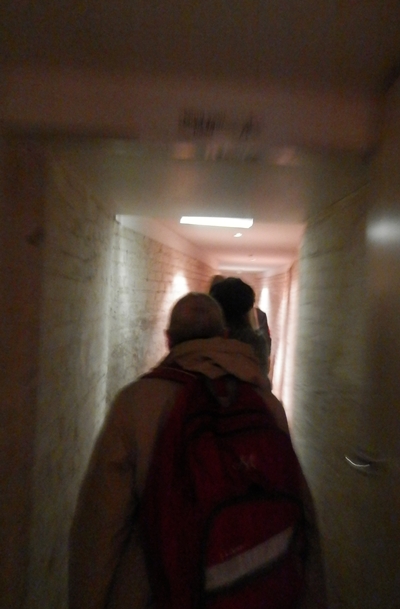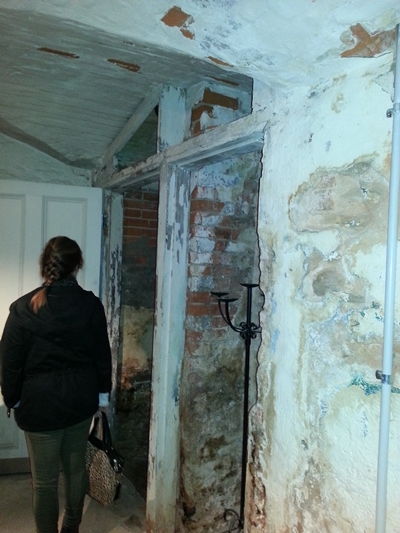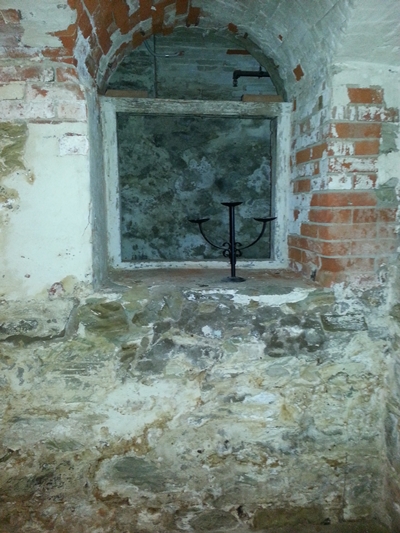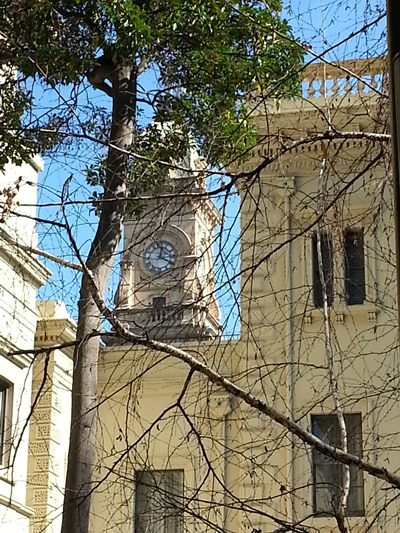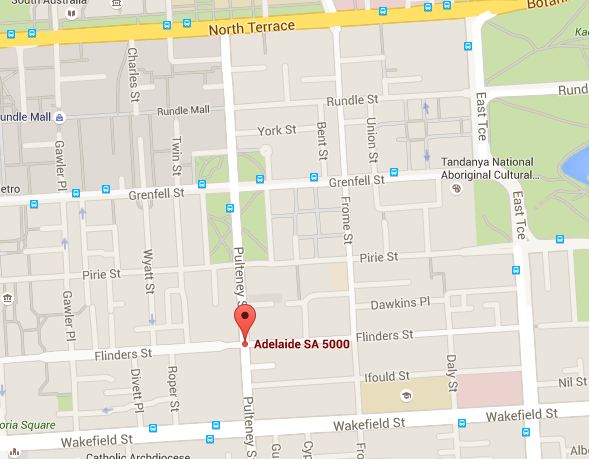Open House Adelaide 2015
Back in 2012 and 2013 Open House Adelaide was a part of the About Time History Month celebrations, with one weekend in May being when all the “Open House” events were on.
I noted that they were not part of this year’s History Month celebrations, so I have been keeping an eye out for when they were on, and have discovered that Open House Adelaide will be a part of the Festival and Architecture and Design (FAD) which runs from 8-13 October 2015.
This Festival is said to …
“… deliver a fun, engaging and informative program of architecture and design talks, forums, exhibitions, performing arts, children’s activities, guided walking tours and the return of Open House Adelaide program”.
For those not familiar with what Open House Adelaide is, it is a weekend where businesses, buildings and historical places around the city open their doors for you to wander through, look at the history and architecture and enjoy seeing parts of Adelaide you may not have seen before.
If you visit the FAD website, you can find details of all 40 or so events, tours, talks, workshops and more including all the Open House Adelaide ones too.
 Adelaide is just one of four Australian cities that have taken on the”Open House” idea, which is actually a global idea, and continues to grow each year.
Adelaide is just one of four Australian cities that have taken on the”Open House” idea, which is actually a global idea, and continues to grow each year.
Adelaide – http://www.fad.org.au/
Brisbane – http://brisbaneopenhouse.com.au/
Melbourne – http://www.openhousemelbourne.org/
Perth – http://www.openhouseperth.net/
To see what other cities around the world that are taking part, visit the Open House Worldwide website http://www.openhouseworldwide.org/.
Do yourself a favour, and explore the buildings in your city. You’ll be surprised what you don’t know, and how cool they really are.
Adelaide’s “Old Treasury” Building and the Underground Tunnels
In Australia National Family History Month is held during August, so it was timely that a historical place I’d been wanting to check out had another open day during the month. Not that they had planned it as far as I know, but hey I’m counting it towards my National Family History Month (NFHM) activities.
Adelaide’s old Treasury Building (which is now hotel apartments, “the Adina Apartments Hotel“) on Flinders Street in the heart of Adelaide, has a history dating back to the early years of the colony.
This former Treasury Building was built in stages from 1839 to 1907, and is a building that has been at the centre of South Australia’s administrative and governmental affairs for more 130 years. And one of the original walls still stands. It housed the Cabinet Room from 1876 until 1968, before that moved to another building. For more on this history of this magnificent building you can read about it here.
Booked in for the 11.00am tour, we were joined by about 60 other people keen to explore the history of this place. Divided into two groups for the actual tour, the group I was with was led by Grant who’s a volunteer at the National Trust, and clearly loves what he does, knows his history, and shares it with enthusiasm.
Firstly Grant showed us the “Records Room” that was made as a fire proof room … which originally had with slate floor, and arched brick ceiling – and held together without any mortar, just simply by the curvature of the bricks. From a genealogical perspective, it’s so good to know that they were looking after the records, not only ensuring that they were kept, but they were also kept safe!
Anyway you will see from the photo below they have now added steel rods as reinforcement, but the ceiling is still there, and is still the original one, and looks amazing. The room itself is now an actual apartment … and an very nice one at that.
The tunnels underneath the Treasury Building were constructed in 1850 and predate the existing building, and it is understood that gold discovered by South Australian diggers in the Victorian Goldfields was stored and smelted in there tunnels, as they contain a furnace and a well.
There are two tunnels, one that runs from the Adelaide GPO on Franklin Street so that government mail could be delivered in secret, and another is thought to lead under Flinders Street to the Torrens Building on the corner of Wakefield Street and Victoria Square, however, it has been blocked for many years.
If you were to go on the “tunnels tour” expecting to walk everywhere under Adelaide, you would certainly be disappointed. The one hour tour ended up being an hour and a quarter anyway, but most of that wasn’t on the tunnels themselves. But if you are interested in the history of building, and Adelaide’s history – do yourself a favour and book in for a tour, you’ll certainly be fascintated hearing all the stories.
More Free Websites for South Australia Genealogy and History
Back in 2011 I compiled my 33 Free Websites for South Australia Genealogy post, and despite having written it almost 4 years ago, it is still one of the most looked at posts on my blog.
Since then a lot of new South Australian records and sites have gone online, so I felt it was time for an update.
Many people think that genealogy costs a lot of money, let me tell you that all of the links below are free. Personally I find that it’s often a matter of knowing where to look beyond the big-name websites, and hopefully this will help with that.
Although I haven’t titled this “Discovering Links”, I’m putting in that series of posts since it contains a whole bunch of links. These are I have discovered, or found useful, and want to share with others. You can see my previous Discovering Links posts here.
It’s not intended to be an exhaustive collection of links, but simply ones that many will find useful, and it may include some that you may not have known about.
=== SOUTH AUSTRALIA ===
GENERAL HISTORY
South Australian Historical Archaeology Database
The Historical Archaeology of Adelaide Project is based in the Department of Archaeology, Flinders University. It is a long term project to record and document archaeological data from three key site types throughout South Australia: cemeteries, standing structures (buildings), and monuments/memorials. The project data has been compiled by second and third year undergraduate archaeology students as part of their work in the topic. These databases are available as a public resource for heritage research.
History As it Happens
History is not only about things that happened long ago. It is happening here and now and we are all part of it. Sometimes history is about small things – the everyday things we take for granted. At other times it is about the big events that change communities in dramatic ways and that live on in a community’s memory for generations. History as it Happens pulls together South Australian’s responses to these tragic events. They invite you to share photos, stories, and footage through their website or Facebook page. They’re also keen to obtain artifacts as well.
South Australian Health Museum
South Australian Health Museum is a virtual (online) museum showcases objects and biographies from the collections of: Royal Adelaide Hospital Heritage Office; Calvary Hospital; The Queen Elizabeth Hospital; South Australian Dental Historical Society and St John Ambulance Museum. There’s amazing collections of items to view, from equipment , to dental copper amalgam, an operating table, prosthetic limbs, medical booklets, and numerous old photographs. Note, this sites does not contain any individual’s medical records.
Adelaide City Heritage
Adelaide City Heritage is a website dedicated to “discovering, exploring, celebrating and protecting the heritage of the City of Adelaide”.
Adelaidia
Learn about the history of Adelaide, through Adelaidia. It is an interactive way of engaging with the history of this city. The site is full of stories of the city’s people, places and events, the city streets and the buildings and monuments that line them, and the events that enliven them. Share your stories of the city, your favorite images and your responses. This site is a work in progress and continues to grow over time and aims to become a comprehensive and multifacteted history that truly reflects Adelaide’s history.
Manning’s Place Names of South Australia Index
Geoff Manning and has dedicated a large portion of his life pursuing his passion for finding and recording the origins of South Australian places. His various printed editions of “Manning’s Place Names of South Australia” grew incredibly with each printing. Now the State Library of SA has much of this information on their website.
SA Memory
SA Memory is an online gateway to South Australian culture and heritage, past and present. This multimedia website focuses on the South Australian experience – what makes South Australia different from other places. SA Memory illustrates and interprets themes highlighting South Australia’s people, places, issues and events from the colony’s beginnings to now: South Australia’s ‘memory’. SA Memory showcases a wide range of archival and published materials and allows users to read original documents and transcripts; view images – photographs, posters, art works, interactive maps, and more; listen to sound recordings, including oral histories; and watch historic film footage. Many of these materials have previously only been accessible to visitors at various archives. Search by name, by place, or by theme – there’s plenty to view on this website.
Location SA Map Viewer
Have you ever wanted to know where your nearest shipwreck is, or every earthquake location in SA since 1836? You can check all of these things and more from the Location SA Map Viewer. Government spatial data has been combined on a single website, allowing easy access to everything from public transport to planning development zones and Marine Parks in one view.
MILITARY
A World Away – South Australia’s War
HistorySA is behind this fabulous site. When war broke out a world away in Europe, South Australians could not have imagined how it would impact their lives. ‘A World Away’ documents the experiences of South Australians in their own words – through diaries, letters and newspapers – and in real time, 100 years after the events. Come on a journey, month by month, as HistorySA delves into the lives of South Australians on the front lines and the home front during the First World War.
South Australian Red Cross 1916-1919
This website allows users to search the records of the South Australian Red Cross Information Bureau held in the collection of the State Library of South Australia (SLSA). From 1916 until 1919, the South Australian Red Cross Information Bureau (SARCIB) performed the service of undertaking research into 8,033 enquiries from family and friends of missing Australian Imperial Force (AIF) personnel fighting in World War 1. Documentation produced and received in the process of making these enquiries is included in the ‘packets’ of records that can be searched and viewed on this website.
South Australians of World War 1
Flickr is the place that the State Library of South Australia (SLSA) has uploaded over 1700 photographs of WW1 soliders. If you have an ancestor from South Australia who was in WW1, be sure to check their collection.
OLD MAPS AND PHOTOS
Map of Adelaide 1849
Plan Of Country Sections &c In The Immediate Vicinity Of The City Of Adelaide In The Province Of South Australia 1849. Scanned at high-res you can view this map in full, or zoom in to see the detail.
South Australian Railways (SAR) Maps
If you’re interested in South Australian railway history, you’ll be interested in these maps on Johnny’s Pages. A railway enthusiast, he has high-res images of South Australian railway maps which you can click for high-res images.
Port Adelaide / Enfield Local History Photos
The Port Adelaide Enfield Local History Group have collected over 3000 historical photographs and have put them up on Flickr. People, buildings and other things relevant to the area are shown.
RECORDS
South Australian Directories and Almanacs 1864-1973
The State Library of South Australia have digitised over 100 years of South Australian Directories and Almanacs, making them freely available to everyone through their website. From the first, the directories included mercantile, ecclesiastical, legal, and other occupational and trade listings. Like modern telephone books, this eventually developed into a comprehensive ‘trades and professions’ section.
South East Collection of Records
I did include this link in my earlier list, however the list of records has grown since then, so is worth a re-look if you haven’t recently. Also I wanted to mention that the SEFHG holds records relating to the following towns in South Australia: Allendale, Beachport, Canunda, Caroline, Carpenter Rocks, Cape Jaffa, Compton, Donovans, Drop Drop, Glenburnie, Glencoe, Gran Gran, Harris Range, Hatherleigh, Kalangadoo, Kangaroo Inn, Kingston, Kongorong, Lucindale, McGrath Flat, Mil Lel, Millicent, Moorak, Mount Burr, Mount McIntyre, Mount Gambier, Mount Muirhead, Mount Schank, Mundulla, Murrimbum, Nangula, Nangwarry, Naracoorte, Narrung, OB Flat, Penguin Island, Port MacDonnell, Penola, Rendelsham, Robe, Sebastapol, Snuggery, South End, Suttontown, Tantanoola, Tarpeena, Tintinara, Tatiara, Wandilo, Wyrie, and Yahl.
Australian Medical Pioneers Index (AMPI)
This is an Australia-wide site, but it does list some from South Australia, so is a useful resource for researchers if you had doctors or others in the medical profession prior to 1875. AMPI provides biographical data on over 4500 doctors who lived in Australia (or visited Australian shores in a medical capacity) in colonial days.
South Australian Land Records from 1858
It was big news when it was announced that the South Australian Integrated Land Information System (SAILIS) website had South Australian land records online AND free (the historical records anyway). This website allows users to search South Australian land records online from 1858. Look for the “Historical Searches” tab, and follow the links from there. I do suggest watching the short YouTube tutorial first, so you’ll understand how to search.
Adelaide City Council Assessment Books 1846-1870
I have to attribute this link to a customer at work who told me about this. And what a fabulous collection it really is. The Adelaide City Council have digitised their historical rate assessment books and they are viewable online. The books are in table format, and the columns list: No. of Assessment, Name of Occupier, Lessor or Landlord, Name of Owner, Description of Property Assessed, No. of Acre, Situation or Name or Street, Net Annual Value after deductions, Amount of rate chargeable for 12 month, Arrears, Remarks. A valuable resource for those who had family who lived or owned property in the city during this period.
South Australian Photographers 1845-1915
This 337 page book written by R.J. “Bob” Noye, and published in 1997. Containing an extensive A-Z listing South Australian photographers, with biographical details of each, this will be useful for anyone wanting help dating photographs.
South Australian Adoption Records
Monash University have an extensive list that details various collections relating to South Australian adoptions and where you can find them.
Find and Connect
Find and Connect is an Australia-wide site that contains history and information on children’s homes, orphanages, and other institutions. It brings together historical resources relating to institutional ‘care’ in Australia. You can use it to read information about and view images of children’s homes, get help to find records about your childhood in ‘care’, and connect with support groups and services in your state/territory. Please note, it does not contain private records.
SHIPPING
Log of Logs Volumes 1, 2 and 3
Not strictly South Australian, but rather Australia-wide, the three volumes of Log of Logs were released in printed book for during the 1990s, and were very popular. Afterall they are essentially a catalogue of logs, journals, shipboard diaries, letters and all forms of voyage narratives from 1788 to 1998, for Australia and New Zealand, as well as the surrounding oceans. And who doesn’t want to know if references and records for their ancestors’ voyage survived? The volumes are now available to read online or download for free.
Immigrants to South Australia, (UK, assisted passage) 1847-1886
I have listed The Ships List on my earlier post, and this is one of the collections that you’ll find on this amazing site. This is an ongoing project detailing immigrants arriving in South Australia, mostly under UK assisted passage schemes from 1847 through to 1886. These lists have been transcribed from the original passenger lists, and where available, extracts regarding a particular ship have been included, from the Sydney Shipping Gazette and the South Australian Register. The South Australian Government Gazette (return showing deaths on board Emigrant ships 1849 to 5th June 1865) has also been consulted.
Bound For South Australia
The precise number of people who travelled to South Australia in 1836 intending to settle will probably never be known with certainty. Available sources include inconsistencies, and all were subject to last minute changes, as additional passengers embarked, or expected passengers changed their minds. A few left the ships en route, some were born and others died. This website contains passenger lists for the Duke of York, John Pirie, Cygnet, Lady Mary Pelham, Emma, Rapid, Africaine voyages during 1836.
CONNECTING AND SOCIAL MEDIA
South Australia Genealogy Facebook Group
If you are a Facebooker, and are researching family in South Australia, be sure to join this group, as you can post your queries here.
Cousin Connect South Australia
If a forums is more your thing, Cousin Connect has a specifically South Australian section for you to post your queries to.
RootsChat – Australia
RootsChat is another forum, a place for you to put your query out there, and while RootsChat doesn’t have a specific South Australia category, you can find many queries relating to SA on it.
RootsWeb – South Australia
RootsWeb is the original genealogy mailing list, and it’s the largest with about 36,000 different mailiang lists. And they have a category specific for South Australian genealogy and queries. If you sign up to their mailing list you not only get copies of each South Australia query, but it allows you to send your own query so everyone else who is subscribed will get your query, and will hopefully be able to answer. The good thing about a mailing list as opposed to message board or Facebook is that Google indexes them – so people can still find your query years later!!
21 December 1860 – The Date Water Was Turned on in Adelaide
The date 21 December 1860 was a Friday, and this was a big day for the city of Adelaide, as that is the day that the water from the pipeline in the Adelaide Hills was turned on, and water came through. The time was 3.00pm, and a small group of people surrounded the fire hydrant on the corner of Flinders and Pulteney Streets, and then it was time.
They turned in on … and … the water didn’t just come, it GUSHED! In fact it gushed 7o feet into the air!! It sounds spectacular doesn’t it. And in fact the water coming to Adelaide, changed Adelaide’s history.
It was obviously mighty useful for the local fire service of the time. It meant the city could have drinking fountains, and water was also used to power the first non-passenger lift to be installed in Adelaide which allowed goods up and down several floors, which by the way was Harris Scarfes. And thanks to the vast reach and power of the water, it was used to clean multi-storey buildings in the city as well.
I got all of these interesting, useful tid-bits of history from the South Australian Engineers Heritage Conference that I attended last week. Being an Engineering history conference, of course the history of water supply and pipelines fall into the category!
Anyway back to Adelaide’s water … all didn’t go smoothly with the work on the pipeline and reservoir, but then again does anything? Here’s an article from the beginning of 1860 which mentions a few of the problems. This is just a portion of the article, so if you want to read the full entry just click on the hyperlink in the caption.
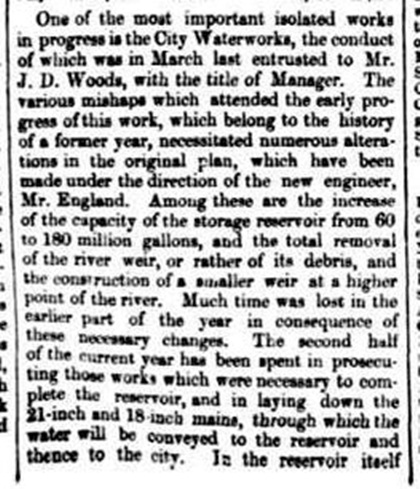
South Australian Register, 3 January 1860, p.3.
http://nla.gov.au/nla.news-article49896163
Work obviously continued throughout the year, and in December along with the excitement of Christmas … came the excitement of Adelaide’s water supply being turned on.
There’s a number of articles about the event. Though surprisinlgy none made front page news, or mention a big street parade.
Now I shall leave you with the small snippet article from the South Australian Advertiser the day after the big event …
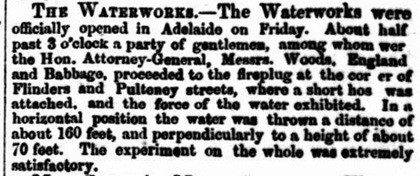
The South Australian Advertiser, 22 December 1860, p.2
http://nla.gov.au/nla.news-article828181
And if you wish to read about Adelaide’s Waterworks achievement further, here’s a few more articles thanks to the awesomeness of Trove.
27 December 1860 – South Australian Register, p.2
29 December 1860 – Adelaide Observer, p.5
29 December 1860 – South Australian Weekly Chronicle, p.3
31 December 1860 – South Australian Register, p.2
There’s no doubt that we take water on tap for granted. We shouldn’t, but having not lived without it, it just doesn’t enter our head to think of what life would be like without it. But one thing is for sure, 21 December 1860 certainly changed Adelaide’s history!

